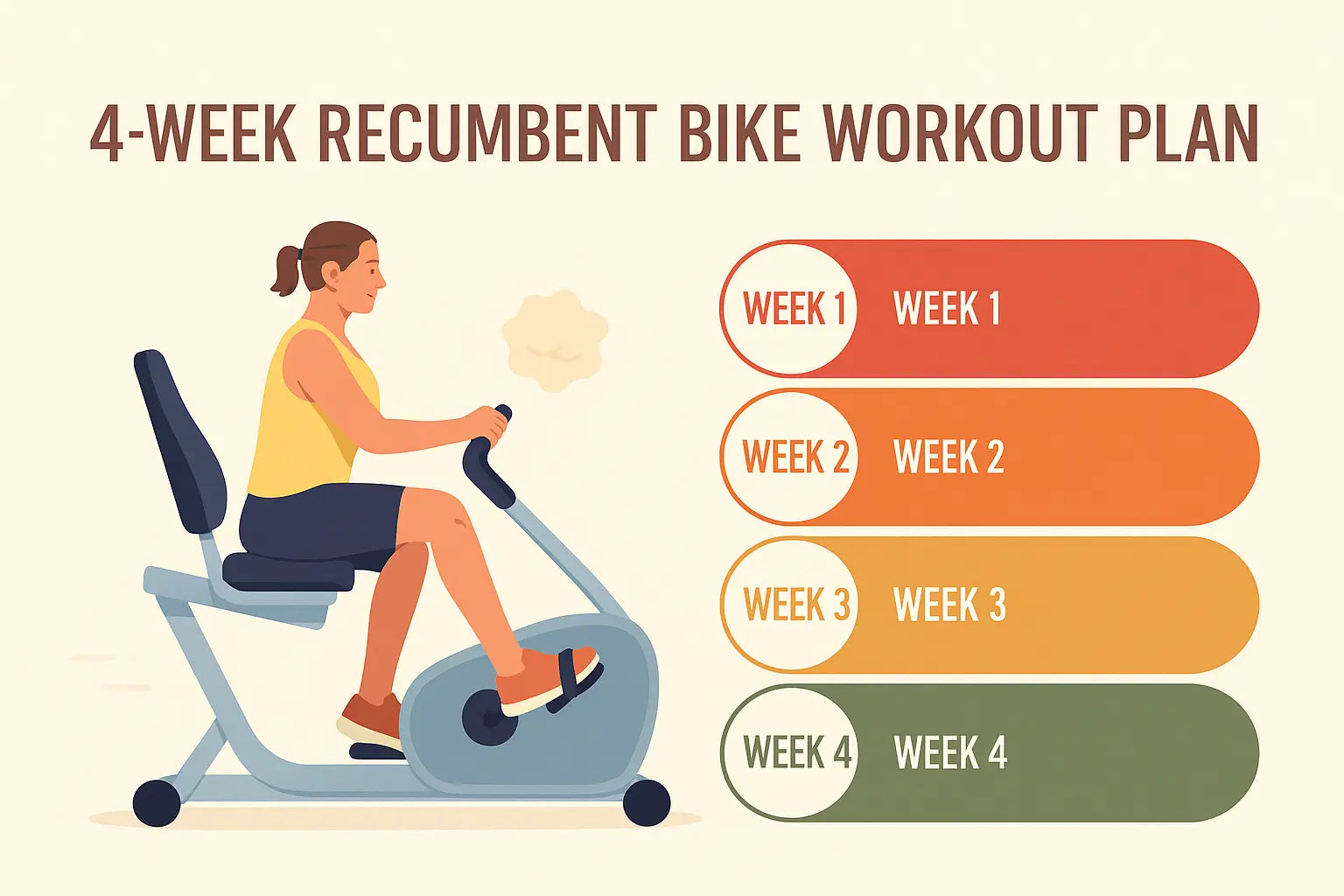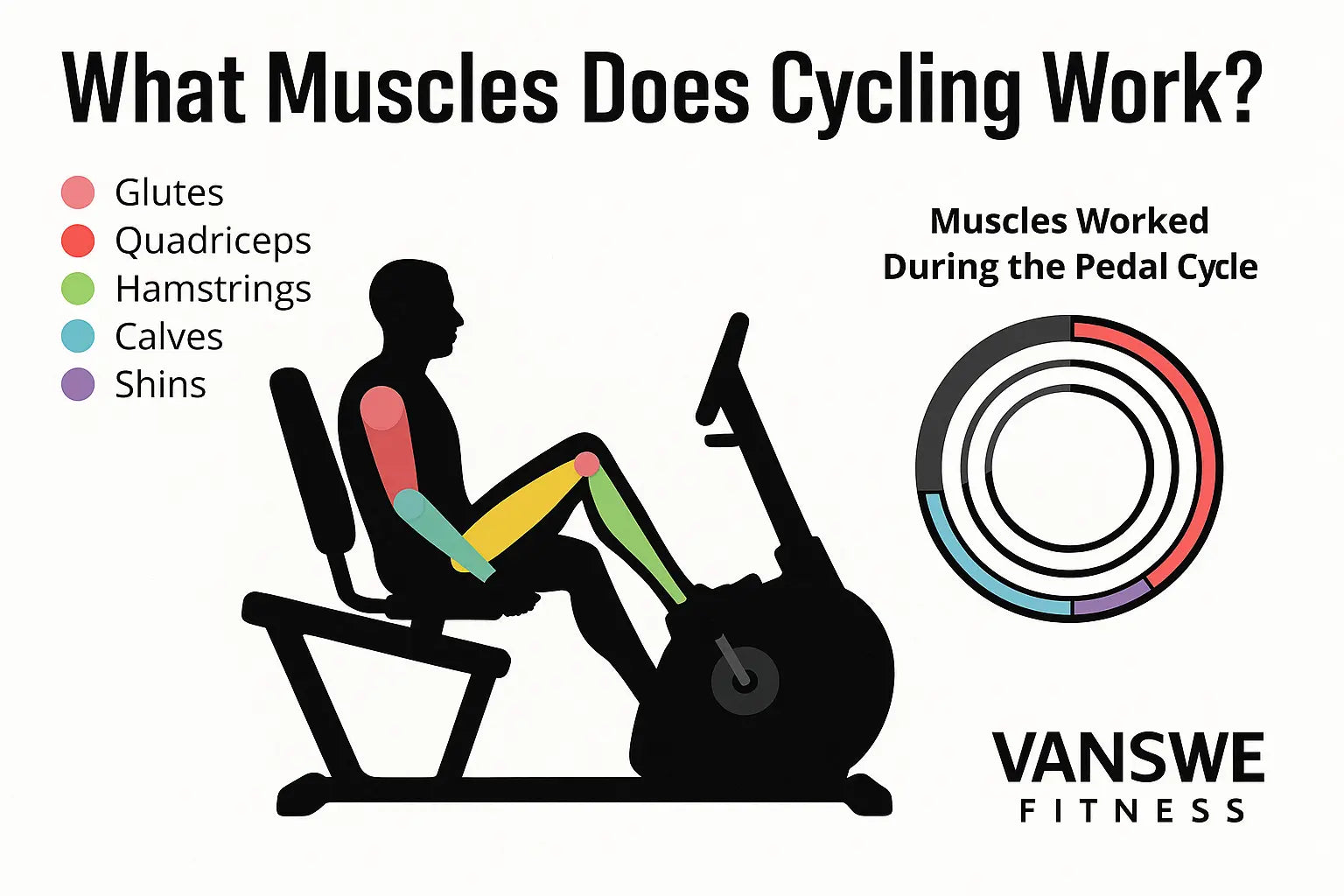Recumbent Bike Workout for Beginners: How to Start Safely and Get Results

A recumbent bike is one of the safest and easiest cardio machines for beginners. With a supportive seat, reclined position, and low-impact pedaling, it’s ideal for those new to fitness, returning after a break, or recovering from injury. This beginner-friendly guide explains why a recumbent bike is a smart starting point, how to get set up, and provides a step-by-step 4-week workout plan to help you build endurance and see results safely.
In this guide, you'll learn why the recumbent bike is a smart choice for beginners, how to get started, what a 4-week workout plan looks like, and how to avoid common mistakes.
Why Choose a Recumbent Bike?
A recumbent bike is an ideal choice for your first workout because it offers comfort, stability, and low-impact cardio that's easy on the joints. Its reclined seat supports your back, making it especially suitable for beginners, older adults, or those with limited mobility.
- Comfort: The large seat with back support reduces strain on the lower back.
- Low impact: Gentle on joints, especially knees and hips, making it safer for overweight users or those with arthritis.
- Stability: The reclined design provides balance and reduces the risk of falls.
- Simplicity: Easy to use with minimal setup or skill required.
According to a 2012 study in The Gerontological Society of America [1] established clinically relevant fitness benchmarks to help older adults maintain physical independence—guidelines that support the use of low-impact exercises like recumbent cycling to promote functional health.
Related Article: What are the Benefits of a Recumbent Bike?
Getting Started: What You Need Before You Ride
Before riding a recumbent bike, it’s important to set up your equipment and gear properly to ensure a safe and effective workout. Adjust the seat for comfort, wear supportive shoes, and stay hydrated to avoid injury and maximize results.
-
Adjust the seat so your legs are slightly bent when the pedal is at its farthest point.
-
Wear proper shoes with non-slip soles.
-
Dress comfortably, preferably in moisture-wicking athletic wear.
-
Hydration and towel: Keep water and a towel nearby.
-
Optional but recommended:
- Fitness tracker to monitor heart rate
- Recumbent bike with magnetic resistance and digital display
Beginner-Friendly Workout Plan (Week 1–4)
Beginners should start with 15–30 minutes of recumbent biking, 3 to 5 times per week. Gradually increase your workout duration over four weeks to build endurance. For optimal heart health and weight management, aim for at least 150 minutes of moderate-intensity cycling weekly, as recommended by the American Heart Association.
| Week | Duration | Resistance | Focus | Notes |
|---|---|---|---|---|
| 1 | 15 mins | Low | Getting comfortable | Use minimal resistance, steady pace |
| 2 | 20 mins | Low-Mid | Intro to Intervals | 2 min slow + 30 sec fast x 5 rounds |
| 3 | 25 mins | Mid | Resistance endurance | Ride at a consistent pace |
| 4 | 30 mins | Mid-High | Cardio and stamina building | Alternate 3 min easy + 2 min push |
Source: Aim to ride 3–5 times per week for optimal cardiovascular benefits. The American Heart Association [2] recommends at least 150 minutes of moderate-intensity aerobic activity per week .
Related Article: Recumbent Bike for Weight Loss: Why You're Not Dropping Pounds
Warm-Up and Cool-Down Routines
Warming up prepares your body and prevents injury, while cooling down aids recovery.
Warm-Up (5 mins):
- 3 minutes of slow pedaling
- 2 minutes of dynamic stretches (e.g., leg swings, arm circles)
Cool-Down (5 mins):
- 3 minutes of easy pedaling
- Stretching: Focus on calves, hamstrings, quads, and glutes
Tips for a Successful Beginner Workout
To get the most out of your beginner recumbent bike workouts, focus on proper form, gradual progress, and consistency. Starting slow, maintaining good posture, and tracking your heart rate can help you build endurance safely and effectively.
- Start slow: Gradually increase time and resistance.
- Maintain posture: Keep your back against the seat, shoulders relaxed.
- Use heart rate monitoring: Target 60–70% of your max heart rate (Zone 2) for fat-burning and endurance.
- Track progress: Log your rides, time, resistance level, and heart rate.
- Stay consistent: Regular rides are key to seeing results.
Common Mistakes to Avoid
New riders often make common mistakes on a recumbent bike, such as using too much resistance, skipping warm-ups, or slouching during the ride. Avoiding these errors can help prevent discomfort, improve results, and ensure a safer workout experience.
- Setting resistance too high too soon
- Leaning forward or slouching
- Skipping warm-up or cool-down
- Riding too infrequently (less than 2x/week)
When Will You See Results?
You can start seeing results from recumbent bike workouts in as little as 2 to 4 weeks, depending on your consistency and effort. Initial improvements may include better energy levels and endurance, while visible fat loss and cardiovascular benefits typically appear after 6 to 8 weeks.
| Timeframe | Expected Results |
|---|---|
| 2 weeks | Increased energy, improved endurance |
| 4 weeks | Mild weight loss, stronger legs |
| 8+ weeks | Visible fat loss, better cardiovascular health |
Note: Combine workouts with a balanced diet and sleep for optimal results.
Recommended Bikes for Beginners
The best recumbent bikes for beginners are easy to use, offer adjustable resistance, and provide back support for comfort and safety. Look for features like a step-through frame, digital display, and heart rate sensors to support an effective and user-friendly workout experience.
- Step-through design for easy access
- Adjustable seat and resistance levels
- Built-in heart rate sensors
Related Article: Best Recumbent Exercise Bikes 2025
Final Thoughts
Starting your fitness journey with a recumbent bike is a smart, safe, and sustainable choice. With its joint-friendly motion and structured workouts, you’ll build endurance and improve your health without overwhelming your body. Stay consistent, listen to your body, and enjoy the ride!
FAQs
Can you get in shape with a recumbent bike?
Yes, you can get in shape with a recumbent bike. Regular workouts improve cardiovascular health, strengthen leg muscles, and boost endurance—all while minimizing joint stress. Riding 3–5 times per week can help build fitness effectively.
What is one disadvantage to riding a recumbent bike?
One disadvantage of riding a recumbent bike is that it burns fewer calories compared to upright bikes or running. Its reclined position limits full-body engagement, making it less intense for high-calorie-burning workouts.
Related Article: Recumbent Bike Pros and Cons: Why Use a Recumbent
Can I lose weight using a recumbent bike?
Yes, you can lose weight using a recumbent bike if combined with consistent exercise and a healthy diet. Aim for at least 150 minutes of moderate-intensity cycling per week to support fat loss and calorie burn.
Reference:
- Rikli, R. E., & Jones, C. J. (2013). Development and validation of criterion-referenced clinically relevant fitness standards for maintaining physical independence in later years. The Gerontologist, 53(2), 255–267. https://doi.org/10.1093/geront/gns071
- American Heart Association. (n.d.). Recommendations for physical activity in adults. https://www.heart.org/en/healthy-living/fitness/fitness-basics/aha-recs-for-physical-activity-in-adults
Latest Articles






